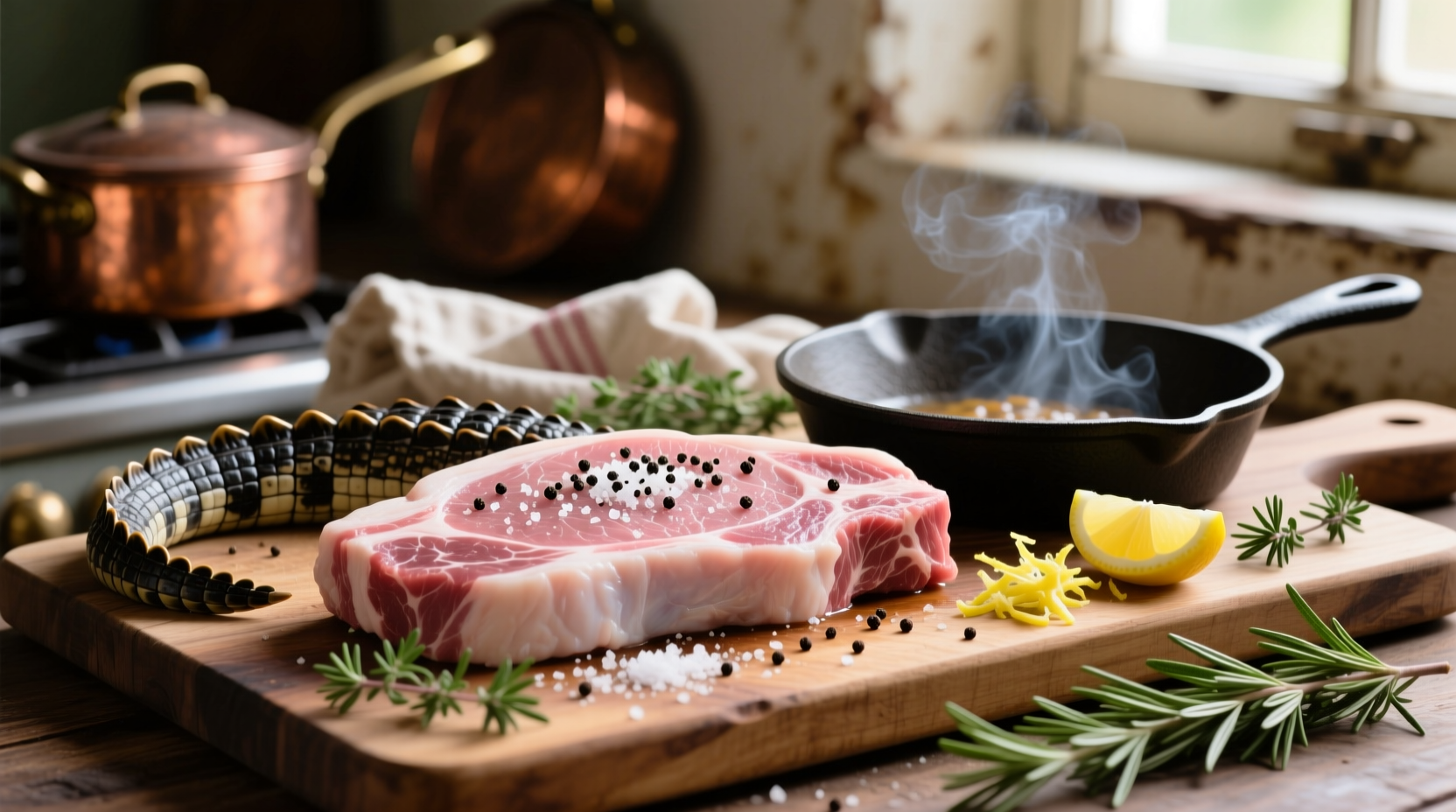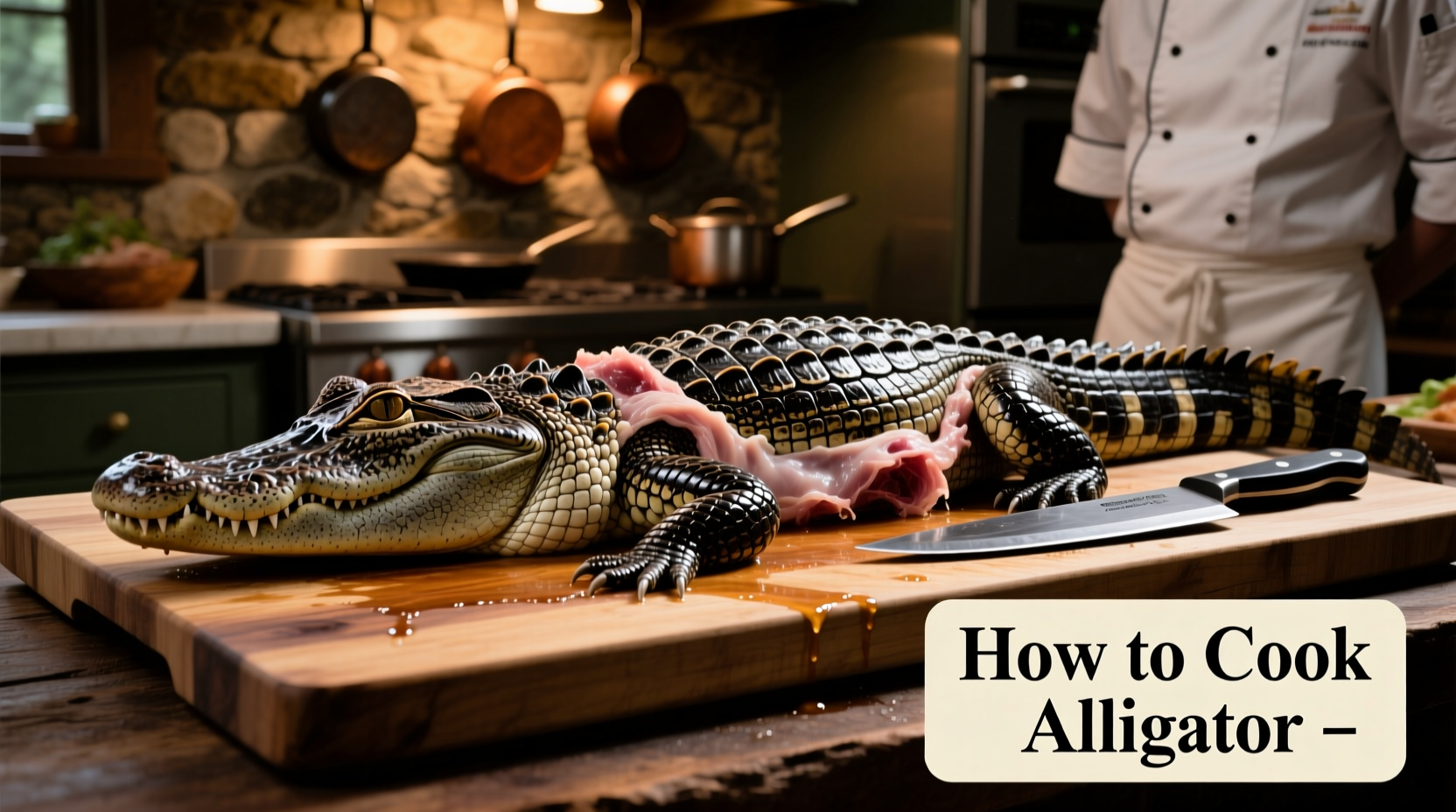Alligator meat is a lean, sustainable protein source with a mild flavor similar to chicken or fish. Properly prepared, it offers a tender texture and can be cooked using frying, grilling, or stewing methods. Always source from licensed suppliers, handle with food safety precautions, and cook to an internal temperature of 165°F (74°C) for safe consumption.
Ever wondered what alligator tastes like or how to transform this unique protein into a delicious meal? You're not alone. As sustainable and exotic food options gain popularity, more home cooks are exploring alligator meat—a culinary tradition deeply rooted in Southern U.S. culture, particularly in Louisiana and Florida. This comprehensive guide delivers everything you need to know to prepare alligator safely and deliciously, whether you've never handled it before or want to refine your technique.
Understanding Alligator Meat: What You're Working With
Alligator meat primarily comes from two sections: the tail (most tender and commonly used) and the legs. The tail meat resembles white fish or chicken breast in texture when properly prepared, while leg meat is darker and slightly tougher. According to the Louisiana Department of Wildlife and Fisheries, alligator farming supports conservation efforts while providing economic benefits to rural communities.
| Nutrition Comparison (per 3oz serving) | Alligator | Chicken Breast | Beef (lean) |
|---|---|---|---|
| Calories | 110 | 140 | 180 |
| Protein | 20g | 26g | 22g |
| Total Fat | 2.5g | 3g | 10g |
| Saturated Fat | 0.5g | 0.8g | 4g |
This nutritional profile makes alligator an excellent choice for health-conscious eaters seeking lean protein alternatives. The Florida Fish and Wildlife Conservation Commission notes that farmed alligators are raised under strict regulations ensuring both animal welfare and food safety standards.
Sourcing Alligator Meat Safely and Legally
Before you start cooking, you need to obtain alligator meat properly:
- Check local regulations: Alligator hunting and sales are regulated by state wildlife agencies. In most states, you must purchase from licensed suppliers rather than hunting yourself.
- Find reputable suppliers: Specialty butcher shops, seafood markets in Southern states, and online exotic meat retailers often carry frozen alligator tail.
- Look for proper labeling: Legally sold alligator meat should include origin information and processing dates.
- Verify freshness: Fresh alligator should have a clean, mild smell with firm, ivory-colored flesh. Avoid any with grayish discoloration or strong odors.
The U.S. Department of Agriculture requires that all exotic meats sold commercially undergo inspection similar to traditional livestock. Always ensure your supplier follows these guidelines for safe consumption.
Essential Safety Considerations
Handling alligator meat requires specific food safety practices:
- Cross-contamination prevention: Use separate cutting boards and utensils for raw alligator, and sanitize thoroughly after use.
- Proper storage: Keep frozen until ready to use, then thaw in the refrigerator (never at room temperature).
- Temperature control: Cook alligator to a minimum internal temperature of 165°F (74°C) as recommended by food safety experts.
- Hand hygiene: Wash hands thoroughly after handling raw alligator meat.

Preparing Alligator for Cooking
Proper preparation makes all the difference in texture and flavor:
- Thawing: Allow 24 hours in the refrigerator for every 5 pounds of meat.
- Cleaning: Rinse under cold water and pat dry with paper towels.
- Trimming: Remove any remaining fat or connective tissue, which can be tough when cooked.
- Cutting: Slice tail meat into 1-inch thick medallions or 1/4-inch strips for stir-fries.
- Marinating: Soak in buttermilk or acidic marinade for 2-4 hours to tenderize and reduce any gamey flavors.
Professional chefs often recommend buttermilk marinades for alligator, as the mild acidity helps tenderize the lean meat without making it mushy. According to culinary research from the Southern Foodways Alliance, traditional Cajun preparations often use buttermilk with garlic and cayenne for optimal results.
Best Cooking Methods for Alligator
Frying Alligator (Classic Approach)
Frying produces crispy, flavorful results perfect for appetizers or main dishes:
- Dredge medallions in seasoned flour (try adding paprika and cayenne for authentic Southern flavor)
- Heat oil to 350°F (175°C) in deep skillet or fryer
- Fry for 3-4 minutes until golden brown and internal temperature reaches 165°F
- Drain on paper towels and serve immediately
Grilling Alligator
Grilling works well for thicker cuts and imparts a delicious smoky flavor:
- Marinate strips in citrus-based marinade for 2-4 hours
- Preheat grill to medium-high heat (about 400°F)
- Oil grates thoroughly to prevent sticking
- Grill for 3-4 minutes per side until cooked through
- Avoid overcooking, which can make the lean meat dry
Slow Cooking and Stewing
For tougher cuts or more complex dishes:
- Brown alligator pieces first for enhanced flavor
- Add to gumbo, jambalaya, or étouffée recipes
- Cook on low heat for 1.5-2 hours to tenderize
- Works particularly well combined with traditional Cajun trinity (onions, celery, bell peppers)
Signature Alligator Recipes to Try
Crispy Alligator Bites with Remoulade Sauce
Prep time: 30 minutes (plus marinating) | Cook time: 15 minutes | Serves: 4
Ingredients:
- 1.5 lbs alligator tail, cut into 1-inch medallions
- 2 cups buttermilk
- 2 cups all-purpose flour
- 1 tbsp cayenne pepper
- 1 tbsp garlic powder
- 1 tbsp paprika
- Salt and black pepper to taste
- Vegetable oil for frying
Remoulade Sauce:
- 1 cup mayonnaise
- 2 tbsp Creole mustard
- 1 tbsp hot sauce
- 1 tbsp lemon juice
- 1 tsp paprika
- 1 clove garlic, minced
- Salt to taste
Instructions:
- Soak alligator in buttermilk for 2-4 hours in refrigerator.
- Mix flour, cayenne, garlic powder, paprika, salt and pepper in shallow dish.
- Heat oil to 350°F in deep fryer or heavy skillet.
- Dredge each medallion in flour mixture, shaking off excess.
- Fry in batches for 3-4 minutes until golden brown and cooked through.
- Drain on paper towels and serve with remoulade sauce.
Serving and Pairing Suggestions
Alligator's mild flavor pairs well with bold seasonings and traditional Southern sides:
- Classic pairing: Serve fried alligator with hushpuppies, coleslaw, and pickled vegetables
- Sauce options: Remoulade, cocktail sauce, or spicy aioli complement the meat's flavor
- Wine pairing: Crisp white wines like Sauvignon Blanc or dry Riesling balance the richness
- Beer pairing: Light lagers or pale ales work well with fried preparations
Storage and Leftover Tips
Proper storage ensures food safety and maintains quality:
- Store raw alligator in coldest part of refrigerator for up to 2 days
- Freeze for longer storage (up to 6 months in airtight packaging)
- Refrigerate cooked leftovers within 2 hours of cooking
- Reheat to 165°F (74°C) before serving
- Use leftovers in salads, tacos, or pasta dishes
Remember that alligator meat is very lean, so it can dry out quickly when reheated. Adding a splash of broth or sauce helps maintain moisture.
Common Questions About Cooking Alligator
What does alligator taste like?
Alligator meat has a mild flavor similar to chicken or fish, with tail meat being particularly tender. When properly prepared, it lacks any strong gamey taste. The texture resembles chicken breast but with slightly more firmness. The flavor readily absorbs seasonings, making it versatile for various culinary preparations.
Is alligator meat safe to eat?
Yes, alligator meat is safe to eat when properly handled and cooked to an internal temperature of 165°F (74°C). Commercially sold alligator comes from regulated farms that follow food safety guidelines. Always purchase from reputable sources and follow standard food safety practices when handling and preparing.
How do I prevent alligator meat from becoming tough?
To prevent toughness: 1) Marinate in buttermilk or acidic marinade for 2-4 hours, 2) Don't overcook (remove from heat at 165°F), 3) Slice against the grain for stir-fries, 4) Use moist cooking methods like stewing for tougher cuts. The tail section is naturally more tender than leg meat.
Where can I buy alligator meat?
You can find alligator meat at specialty butcher shops in Southern states, some seafood markets, and through online exotic meat retailers. Always ensure the supplier is licensed and follows proper food safety regulations. The Louisiana Department of Wildlife and Fisheries maintains a list of licensed alligator farmers who sell meat commercially.
What's the best cut of alligator for beginners?
The tail is the best cut for beginners as it's the most tender and widely available. Tail meat has a consistent texture similar to chicken breast and is versatile for frying, grilling, or adding to stews. Start with tail medallions for frying before attempting more challenging preparations with other cuts.











 浙公网安备
33010002000092号
浙公网安备
33010002000092号 浙B2-20120091-4
浙B2-20120091-4